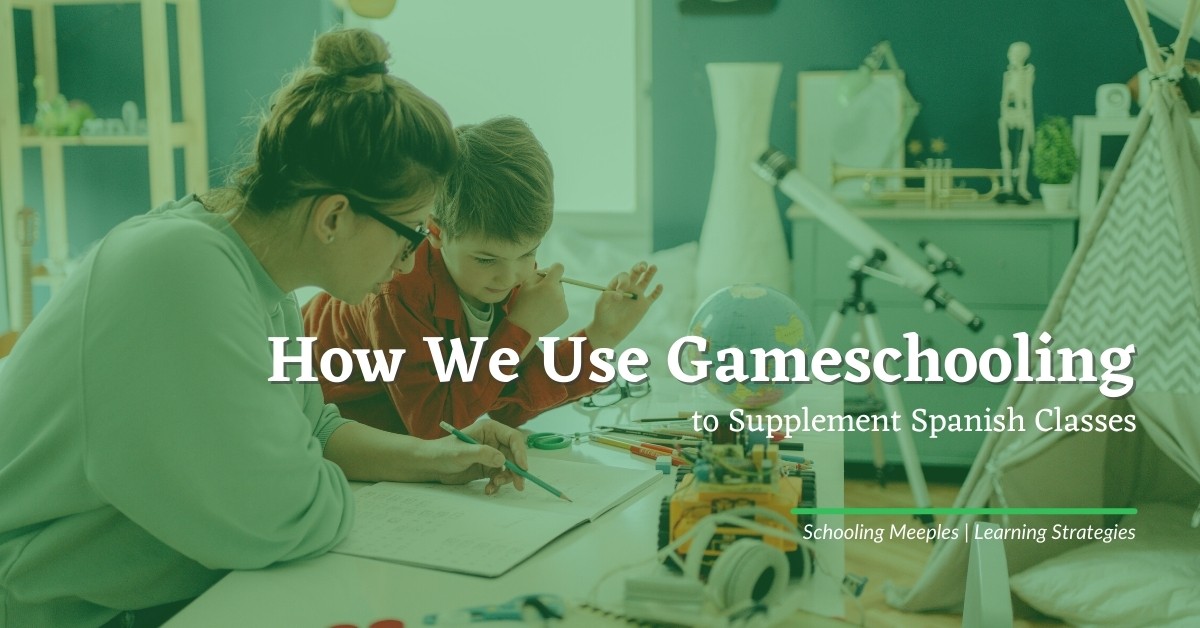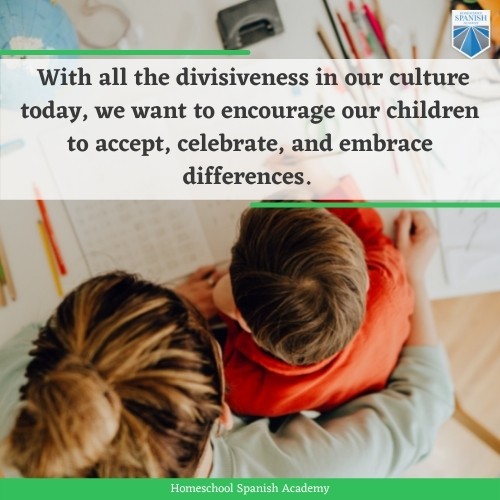
How We Use Gameschooling to Supplement Spanish Classes
I had the opportunity to experience different languages and cultures at a young age as a foreign exchange student, so I personally felt it was important for my children to learn to appreciate different cultures as well. Even more so, with all the divisiveness in our culture today, we want to encourage our children to accept, celebrate, and embrace differences. For us that starts with learning and dialogue—and this is one of the many reasons that we’ve enjoyed the Homeschool Spanish Academy approach.

The Benefits of Learning Spanish Online
Recently, we had the opportunity to start taking Spanish classes online with Homeschool Spanish Academy. The format of short (about 25 minutes) one-on-one sessions with a native Spanish-speaking instructor has worked great for our kids. Also, the printouts they provided for each lesson have helped the learning process and reinforced the material. The best part is that we have been able to use these to make flashcards and games on our own.
The classes with Homeschool Spanish Academy have been a great experience that kickstarted our family to start learning a foreign language together. It was something we had been discussing but without this opportunity, who knows how much longer we would have put it off.
It is not just a language program, it’s an opportunity to introduce the kids to another culture while learning the language!
Even though it’s online, our kids get individualized, “face-to-face” instruction from a native Spanish-speaker that provides natural dialogue. Once the kids get past the initial vocabulary and structure basics, we believe the Homeschool Spanish Academy approach will be even more powerful due to its conversational element. The truth is, there’s no replacement for actual dialogue when learning a language.
What Do the Classes Include?
Besides the content and vocabulary, the classes also include fun mini-games to help engage the kids. These games have been a huge hit with our kindergartener who sometimes struggles to stay focused during lessons. The best part is that the Homeschool Spanish Academy approach complements our homeschooling philosophy, which focuses on social interactions, connections, and engagement to create an environment where learning happens naturally.
Combining Spanish With Gameschooling

To accomplish engaging our kids, we combine traditional methods with a lot of gameschooling.
What is gameschooling?
It has been described in many ways, but it boils down to using games for learning.
Even if the use of games to learn sounds like a novelty, it is nothing new! For example, two thousand years ago Socrates already figured this out when he suggested that education and play go hand in hand by saying: “Don’t use force in training the children in the studies, but rather play. In that way you can better discern what each is naturally directed towards.”
The idea of using games as a form of education is starting to be more widely incorporated by many schools and after-school programs as well. However, the term “gameschooling” has been more typically used by families using games for educational purposes.
Ready to Start? 10 Ways to Incorporate Spanish Into Your Gameschooling

The idea of gameschooling has grown recently to the point where some consider it a sort of homeschool style. Each family’s philosophy and implementation are unique. While some families consider any game beneficial and don’t necessarily seek out games specifically designed and marketed as “educational” games, other families might pick a game designed to cover a certain skill or topic that needs reinforcing or include games as a part of a larger unit of study.
And some other families use games as a large portion of their curriculum when homeschooling, and others use it as a fun way to augment their curriculum or even public schooling. It is important to know that regardless of the game or how gameschooling is implemented, there are plenty of benefits to sitting down and playing.
Valuable Skills Learned Through Play
In addition to building connections and making memories, there are so many skills that can be learned or improved through board gaming, such as:
- turn taking
- following directions
- focus
- observation and attention to detail
- memory
- problem solving
- strategic thinking
- prioritization
- listening and communication
- cooperation
- learning how to win or lose graciously
These are all useful life skills and many of the social skills are even more important in our increasingly digital culture.
Skill-targeting With Games

In addition to the general benefits of gameschooling listed above, some games take it a step further and purposefully incorporate specific educational elements to the game. Sometimes it’s adding numbers on cards to practice math skills or simply listing extra facts about the subject on the cards that can be read while playing. Other times the game simulates real life events or processes to further drive that information home.
Want to see an example?
In a game we have about monarch butterflies, the players earn points by successfully completing the monarch’s migration pattern over several rounds. Without being overly “educational,” the gameplay is based on the true lifecycle of a monarch butterfly. Games like this can be an excellent way to introduce new topics, reinforce subjects, or spark interest.
Gameschooling for Us is Offline
One important thing to note is that when we, Schooling Meeples, talk about “gameschooling” we are referring to board games, not games on digital platforms. While digital games can also provide some of the same educational benefits, we as a family like to focus on the physical versions. We feel there is a level of interaction and engagement between the players that is lost when not sitting down around a table to play a game. We also like the tactile element to the physical board games that you lose out on when playing the same game virtually.
And one benefit we have right now is that the board game industry has exploded in the past few years and there are so many different types of board games covering just about every possible subject or theme.
How to “Gamify” Almost Anything
We understand it is easy to fall down the rabbit hole of acquiring many new games but having a big collection of games isn’t required to gameschool. The great part is that while on this journey we’ve found it’s surprisingly easy to “gamify” almost anything. For example, when our son was younger, the only way we could get him to do anything was to claim it was a game or race. “I bet I can get my pajamas on faster!” was our go to transition to our bedtime routine for a long time. Now he’s finishing up kindergarten, and as we’ve transitioned to using gameschooling as a part of our day and our curriculum, it’s been surprisingly easy to find or create a game around the specific skills or subjects we want to cover.
Both of our children love to play with the neat and beautiful pieces that often come with board games. It’s just one more step to roll some dice or play some cards to move those pieces towards an objective. Once you figure out what excites your child then it becomes even easier.
It is important to remember that you don’t need to own all of the games or find the exact game to fit that situation or learning objective. Maybe your kids have outgrown that traditional game of CandyLand. Write equations on the board or cards or create your own new cards with the Spanish words for the colors. These are simple ways to breathe new life into an old outgrown game and adapt them to a different level of learning.
We routinely use different pieces from different games mashed together to create our own game to try to reinforce something specific. If it’s math, we will get appropriate dice for their level and have them add or subtract to move. If it’s reading, the words will become places that their game pieces can move to if they read the word aloud. Flashcards can be turned into a deck of cards to add variability or uncertainty. Sometimes we suggest a rule and the kids will amend it. Sometimes the rules change, sometimes we ignore certain rules or adapt them to make the game more engaging.
Creative Play Brings Life Lessons
Watching the kids play and craft these games and set the rules is another level of creative play. It has been a blast to watch as their creativity and interests are on display when coming up with their own rules or game designs. These aren’t award-winning or overly complex games, but surprisingly that doesn’t really matter. There is a time and place for more complicated games and following the rules as the kids get older, after all, playing by the rules and working within a set of constraints are more life lessons. But for now the connection, engagement, interaction, fun, creativity, and learning tailored to their level are what’s important! “Frankengames” are what we affectionately call these mashed-up, customized, sometimes improvised, and educational monstrosities.
Educational “Frankengame” Mash-ups
One excellent aspect of these Frankengames I just mentioned is the ability to tailor to their interests across a variety of subjects. For example, our daughter loves dragons and our son loves Minecraft, so adding those themes really piques their interest. Frankengames can be easy to create just by printing some images off the internet. A math game using multiplication to count up dragon eggs or adding up Minecraft components gets the kids much more excited than a normal worksheet with the same problems.
Sometimes the games don’t work out as planned, but still end up as a good learning experience. The key is generating interest, building relationships, and creating engagement to facilitate learning through play.
Reinforcing Memory of Spanish Words with Frankengames

Adding Homeschool Spanish Academy to our homeschool curriculum brought some challenges and opportunities because there is a lot of memorization when learning the vocabulary and phrases, which can be repetitive and boring for the kids. But in order to get the most out of our weekly classes, we do a lot of reinforcement in between to make it fun and keep them interested. Ultimately, we play as many games as we can!
Games We’ve Adapted to Our Spanish Classes
So far, we’ve had great success by combining the Homeschool Spanish Academy lesson plans with some classic games and coming up with our own Spanish Frankengames. Here are some examples of simple games we’ve adapted so far to our Spanish classes:
1. A Frankengame
One of the first games we played was a game we made up to practice and learn some of the new vocabulary introduced during our first lesson.
We cut out the pictures along with their Spanish words from the provided homework print-outs and made flashcards out of them. We turned them over and placed them in a pattern on a game board we borrowed from another game. We grabbed some miniature characters used in other games and set up a little game of exploration with treasure chests and monsters to defeat. To move to each square they had to turn over a flashcard and read the Spanish word pictured.
Having the treasure chests contain mini-marshmallows or chocolate chips can provide some extra motivation if needed!
2. Memory Matching
Printing two copies and making flash cards out of the printable lesson plans and homework makes it easy to put together a simple Memory Matching game where you place pairs of the flash cards face down and take turns flipping two over.
We added the requirement of practicing saying the Spanish word aloud. The objective is trying to collect the most pairs of your vocabulary words but if the two that were flipped don’t match, you turn them back over and have to remember where they were in the future.
3. Bingo
Bingo is easy to implement as well using the homework and cutting out two different 3×3 grids to use as bingo cards. The flashcards from the previous matching game were used to draw from to determine which vocabulary word was the next to be called out.
We read the Spanish word aloud and the kids had to find if that word was on their card and put a token on it. First to get three in a row won. This is easy to adjust and print your own bingo boards and sheets as well to further tailor your child’s learning.
4. Sequence
Sequence traditionally uses a deck of cards and a board with all of the cards displayed at least once on the board, possibly twice. We created our own randomized board of our vocabulary words and used our matching flashcards as a deck of cards. The kids took turns playing a flash card from their hand and putting a token on a matching space on the board with the objective of being the first to get 4 in a row in any direction.
5. Word Swat
We have a Sight Word Swat game that is basically using little fly swatters to find and swat words on the table. This is very easily adapted to words in any language. And kids love swatting things! We would say a word aloud and the kids would try to find and swat that picture on the table.
6. Apples to Apples
We haven’t implemented this yet but it is one we think would be fun to create and play with our kids. If you haven’t played Apples to Apples, it is a game where there are red subject cards (person, place, thing, or event) and green description cards (that can describe the subject cards). One red subject card is turned over and the players take turns picking out of their hand of green description cards one card they think best fits the red subject card. The players try to convince others why theirs is the best option. It is a fun social game but also helps with the communication of ideas and opinions and the art of persuasion. We think it would be fun to try this with some of the Spanish vocabulary words we are learning and it would be easy to type up and create in a simple word document.
Learning Happens Best When Playing
None of these examples above require any expensive or fancy games to play. Most households would likely have these items regardless of whether they were tried and true gameschoolers or just starting out with the idea that play and games can help with learning.
And that is the point.
Gameschooling comes from the idea that learning happens best when playing—and children love to play! So much creativity and enjoyment comes from playing, gameschooling is just an attempt to harness and mold it and it doesn’t have to cost a lot of money.
If you’re interested in checking out more of our adventures, please visit us at Schooling Meeples to learn more!
Take care and game on friends!

Want more free Spanish lessons, fun content, and easy learning strategies? Check these out!
- Language Learning with Netflix: How to Use the Chrome Extension
- Turn Your Life Around: From Passive Bilingualism to Fluency!
- The Beauty of Spanish Sign Language
- Multilingual Mastery: How Many Languages Can You Learn?
- The Journey of Becoming Trilingual
- Saying It Like a Native: Exploring Spanish Idioms
- Adapting Education: Spanish Lessons for All Learning Styles
- Speak Up! Enhance Your Conversational Spanish
- How We Use Gameschooling to Supplement Spanish Classes - June 23, 2021




